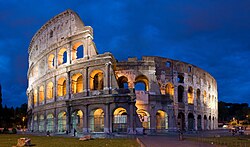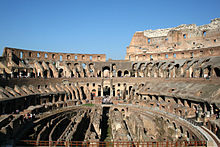Most unique and spectacular pedestrian bridges around the world
Inflatable Trampoline Bridge, Paris
Instead of crossing bridges by walking or by riding a car,
why can’t we bounce or flip our way across instead?
Such a bridge may not be practical, but it would be fun and
no doubt become a tourist attraction. This is what architecture
firm AZC had in mind when they submitted a proposal to
build an inflatable trampoline bridge for pedestrians to
cross the Seine.
The structure involves three inflatable doughnuts like rings with
mesh trampolines stretched across each one, allowing pedestrians to
bounce their way to the other side of the river. It also provides people two
options upon reaching the end of the bridge; to exit by way of a staircase
or by way of a slide.
mesh trampolines stretched across each one, allowing pedestrians to
bounce their way to the other side of the river. It also provides people two
options upon reaching the end of the bridge; to exit by way of a staircase
or by way of a slide.
Titlis Cliff Walk, Switzerlan
Scared of heights? You may not enjoy a stroll across the Titlis Cliff Walk,which
is suspended 1,500 ft above a glacier in the Swiss Alps. This terrifying,
vertigo-inducing pedestrian bridge on Mount Titlis, which opened in 2012
during a huge snow storm, is Europe’s highest suspension bridge at
9,000 ft above sea level.
Constructed over a period of five months, the bridge was built when
weather conditions permitted. Media reports called it the ‘world’s
scariest bridge’ and Switzerland Tourism called it ‘a high-adrenaline
kind of new adventure’.
weather conditions permitted. Media reports called it the ‘world’s
scariest bridge’ and Switzerland Tourism called it ‘a high-adrenaline
kind of new adventure’.
Peak Walk, Switzerland

Peak Walk is a pedestrian bridge linking two mountain peaks in the Swiss Alps. It was built as a tourist attraction in Europe and it cost 1.8 million Francs. Mountains that can be seen from the bridge include Mont Blanc (the Alps’ highest point), the Matterhorn, Mönch, Jungfrau and Eiger and the bridge has a partial glass floor that offers views down through it.
The bridge is 107 m (351 ft) long, 0.8 m (2.6 ft) wide and 1.2 m (3.9 ft) high with a 15% slope. It has four pieces of key supporting steel cables with a 120 tonne loading capacity. The bridge can take up to 300 people, however 150 people at a time have access to the bridge for taking a ‘Sneak Peak’ Walk from one peak to the other.
SkyBridge, Russia
The stomach-turning SkyBridge, near Sochi in south-western Russia, stretches for almost one kilo-meter and can take 30,000 people at a time. Known as the Trollwire, riders are strapped to a zip wire horizontally side by side.
The SkyBridge is also the longest pedestrian suspension bridge in Russia. And if walking across it isn’t adventurous enough for you, you can also bungee jump off it or zip line along it. Whether you choose to walk, bungee or zip line along it, we’d recommend you do so on an empty stomach.
Trift bridge, Switzerland
One of the Alps’ longest and highest pedestrian suspension bridges, Trift was built in 2004 to reconnect hikers to a hut made inaccessible by a retreating glacier. A replacement in 2009 gave this bridge higher handrails and stabilizing cables to prevent it from swinging violently in the wind. The Trift Bridge, which was modeled after Nepalese three-rope bridges turned out to be a tourist magnet. The gondola train, which was originally built as a freight gondola, takes passengers up to the area where the bridge is.
Trift Bridge, the most spectacular pedestrian suspension bridges of the Alps is 100 meters high and 170 meters long; and is poised above the region of the Trift Glacier. Even reaching the bridge through the ravine by cable car is an adventure.
Living root bridges of Meghalaya, India
In most places around the world, bridges are constructed using concrete and steel as the main building materials. However, somewhere in the forests of Meghalaya bridges are not built, they are grown. The living root bridges are made from the roots of Ficus Elastica, the humble Indian rubber tree. The Khasis took notice of the strength and flexibility of the roots and saw an opportunity to make bridges out of them.
Though this ancient technology appears to be theoretically simple, practically it is very difficult as it takes a long time to grow a root bridge. While the construction of modern concrete bridges may take three or four years, these types of bridges take very long to develop into a firm bridge. Normally it takes around 10 to 15 years, which is the normal construction period. These bridges grow to approximately 50 to 100 feet long and have strong and deep roots providing a stable foothold. They can carry up to 50 people at a time.
The life of these bio-engineering wonders is estimated as 500 years which is more than the life span of most of the man made modern bridges. This place receives a lot of rain, so wooden bridges rot and decay. But Root bridges are alive and growing and so gain strength over time.
Capilano Suspension Bridge, Canada
The Capilano Suspension Bridge is situated in a West Coast rain-forest. Originally built in 1889, this award winning pedestrian bridge is one of the Greater Vancouver’s top attractions. Locals and visitors from around the globe enjoy the thrill of crossing the 450-foot (137 m) swaying bridge, suspended 230 feet (70 m) above Capilano River in North Vancouver, BC. The bridge offers splendid views of the river below and old growth forest.
The Capilano Suspension Bridge Park offers visitors a unique mix of adventure, history and culture, which makes this attraction a complete British Columbia experience and a must see while visiting Vancouver.
!!!THERE ARE MANY OTHER AMAZING AND BEAUTIFUL PEDESTRIAN BRIDGES!!!










 2012
2012  2013
2013 2014
2014  2016
2016





